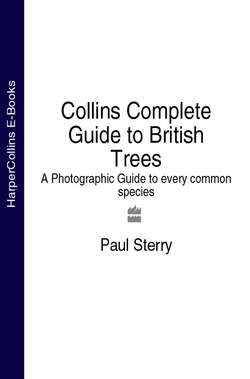Читать книгу Collins Complete Guide to British Trees: A Photographic Guide to every common species - Paul Sterry - Страница 8
GLOSSARY
ОглавлениеAchene – one-seeded dry fruit that does not split.
Acute – sharply pointed.
Alien – introduced by man from another part of the world.
Alternate – not opposite.
Anther – pollen-bearing tip of the stamen.
Auricle – one of a pair of lobes at the base of a leaf.
Axil – angle between the upper surface of a leaf, or its stalk, and the stem on which it is carried.
Berry – fleshy, soft-coated fruit containing several seeds.
Bract – modified, often scale-like leaf found at the base of flower stalks in some species.
Calcareous – containing calcium, the source typically being chalk or limestone.
Calyx – outer part of a flower, comprising the sepals.
Capsule – dry fruit that splits to liberate its seeds.
Catkin – hanging spike of tiny flowers.
Clasping – descriptive of leaf bases that have backward-pointing lobes which wrap around the stem.
Compound – (of leaves) divided into a number of leaflets.
Cordate – heart-shaped at the base.
Corolla – the collective term for the petals.
Cultivar – plant variety created by cultivation.
Deciduous – plant whose leaves fall in autumn.
Dentate – toothed.
Dioecious – having male and female flowers on separate plants.
Drupe – succulent or spongy fruit, usually with a hard-coated single seed.
Entire – (of leaves) with an untoothed margin.
Fruits – the seeds of a plant and their associated structures.
Glabrous – lacking hairs.
Globose – spherical or globular.
Hybrid – plant derived from the cross-fertilisation of two different species.
Inflorescence – the flowering structure in its entirety, including bracts.
Introduced – not native to the region.
Involucre – ring of bracts surrounding a flower or flowers.
Lanceolate – narrow and lance-shaped.
Leaflet – leaf-like segment or lobe of a leaf.
Lenticel – breathing pore on a fruit, shoot or trunk.
Linear – slender and parallel-sided.
Lobe – a division of a leaf.
Midrib – the central vein of a leaf.
Native – occurring naturally in the region and not known to have been introduced.
Oblong – (of leaves) with sides at least partly parallel.
Obtuse – (of leaves) blunt-tipped.
Opposite – (usually of leaves) arising in opposite pairs on the stem.
Oval – leaf shape.
Ovary – structure containing the ovules, or immature seeds.
Ovoid – egg-shaped.
Palmate – (of leaves) with finger-like lobes arising from the same point.
Pedicel – stalk of an individual flower.
Perianth – collective name for a flower’s petals and sepals.
Petals – inner segments of a flower, often colourful.
Petiole – leaf stalk.
Pinnate – (of leaves) with opposite pairs of leaflets and a terminal one.
Pod – elongated fruit, often almost cylindrical, seen in pea family members.
Pollen – tiny grains that contain male sex cells, produced by a flower’s anthers.
Pubescent – with soft, downy hairs.
Rachis – main stalk of a compound leaf or stem of an inflorescence or array of fruits.
Reflexed – bent back at an angle of more than 90 degrees.
Sepal – outer, usually less colourful, segments of a flower.
Stamen – male part of the flower, comprising anther and filament.
Stigma – receptive surface of the female part of a flower, to which pollen adheres.
Style – an element of the female part of the flower, sitting on the ovary and supporting the stigma.
Tepal – perianth segment when petals and sepals are not identifiably separable.
Tomentose – covered in cottony hairs.
Whorl – several leaves or branches arising from the same point on a stem.
